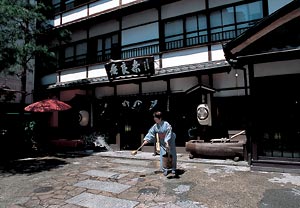 |
|
NIPPONIA No.26 September 15, 2003
|
|
Special Feature*
Staying the Night at a Spa
Written by Yamaguchi Yumi, travel writer
Photos by Omori Hiroyuki
Collaboration: Nara-ya Ryokan
|
Japan certainly is a land of hot springs — there are more than 26,000 of them all over the country. And according to geologists, modern techniques for exploration and deep-drilling make it possible to get mineral water to gush up almost anywhere in the archipelago.
Hot springs are a part of life for many people in Japan. Since ancient times the Japanese have bathed in spas with enthusiasm, and they have developed many enjoyable ways to spend time near the steaming, natural waters.
Kusatsu Spa is almost in the middle of Honshu, in northwestern Gunma Prefecture. It is one of Japan's best known hot springs. Some people say the legendary hero Prince Yamato Takeru discovered it in ancient times; others say it was found by the Buddhist monk Gyoki (668-749).
|
|

In front of Nara-ya Ryokan. The inn opened almost 130 years ago. It is a wooden, 3-storied structure, located very close to Yubatake.
|
For some reason, Buddhist monks and priests often appear in the history of spas in old Japan. In those days, when medical treatment was rudimentary, people would have thought mineral waters had a special power that could heal wounds and ailments. This may explain why legends have associated famous holy monks with hot springs.
After my companion and I arrived in the town of Kusatsu, we decided to walk from the bus terminal to the ryokan (Japanese inn). One of the first things to strike our eyes was a large upwelling of water at a place called Yubatake("Steaming Water Field"). The name "field" comes from the neat rows of wooden troughs containing steaming mineral water from the spring. The water gushes out of the ground at 56°C (132.8°F), which is much too hot to bathe in, so it is channeled through the "field" to cool it. Surrounding the "field" is an open space where you can relax and enjoy the day.
Many ryokan that have served the bath crowd for decades are situated near the "field." We had reserved a room in Nara-ya, which opened almost 130 years ago. We ducked through the hanging noren curtain at the entrance, and were immediately greeted by the cheerful voice of the attendant.
First, we arranged for the night's lodgings at the reception counter. Then a nakai (maid for overnight guests) showed us to our room. This is a good time to ask about the spa — for example, where the baths are, and what you need to know when using them.
|
 |